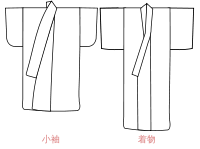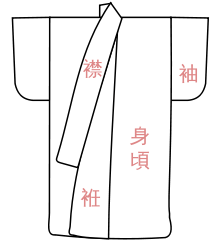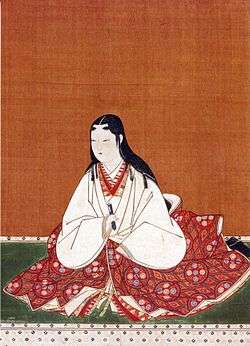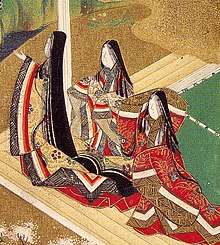Kosode
The Kosode (小袖, lit. "small sleeves") is a basic Japanese robe for both men and women; the literal meaning of the term kosode is "small sleeve", which refers to the sleeve opening. It is worn both as an undergarment and an overgarment, as such it is sometimes interchangeable with a nagajuban (長襦袢, lit. "long undergarment"). The kosode were traditionally worn during the Japanese Edo Period (1600–1868).


Kosode are T-shaped, have a looser fit than the kimono and come in varying lengths. Kosode are worn with an obi (sash), that is considerably smaller than that of the modern kimono. Often worn with hakama (pleated, divided skirt) for men or naga-bakama (very long hakama) for women, as in the case of the miko.
Kosode evolved at some point in the late 14th century and replaced the many layered, unlined hirosodes. Over time kosode gradually developed into a wide variety of styles, with patterns and fabrics.
Parts
- 袖 (Sode) – Sleeves
- 襟 (Eri) – Collar
- 身頃 (Migoro) – body panels
- 袵 (Okumi) – overlap panels
Gallery
 Kosode with yuzen dyeing inside fan and snowflake shapes, 1700s, Ishikawa Prefectural Museum of Traditional Arts and Crafts
Kosode with yuzen dyeing inside fan and snowflake shapes, 1700s, Ishikawa Prefectural Museum of Traditional Arts and Crafts- Kosode for a woman, late 18th century, Honolulu Museum of Art
_with_Mandarin_Orange_Tree_and_Auspicious_Characters_MET_2002.325.jpg) Kosode with Mandarin Orange Tree and Auspicious Characters, late 18th century, Metropolitan Museum of Art
Kosode with Mandarin Orange Tree and Auspicious Characters, late 18th century, Metropolitan Museum of Art Kosode for a woman with design inspired by Eight Views of Ōmi, 1780–1820, Khalili Collection of Japanese Kimono
Kosode for a woman with design inspired by Eight Views of Ōmi, 1780–1820, Khalili Collection of Japanese Kimono Kosode for a woman showing flowers on rafts, late 19th century, Khalili Collection of Japanese Kimono
Kosode for a woman showing flowers on rafts, late 19th century, Khalili Collection of Japanese Kimono
References
- Fashion Encyclopedia
- Gluckman, Dale Carolyn, and Sharon Sadako Takeda, eds. When Art Became Fashion: Kosode in Edo-Period Japan. New York: Weatherhill, 1992.
- Kennedy, Alan. Japanese Costume: History and Tradition. New York: Rizzoli, 1990.
- Kosode: 16th–19th Century Textiles from the Nomura Collection. New York: Kodansha International, 1985.
External links
- Momoyama, Japanese Art in the Age of Grandeur, an exhibition catalog from The Metropolitan Museum of Art (fully available online as PDF), which contains material on Kosode
- Tokyo National Museum – an example of period clothing, including Kosode.
- The Tale of Genji Costume Museum – Includes period clothing, including Kosode.
- Kosode Made Simple
- Kyoto National Museum

